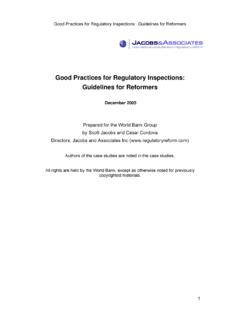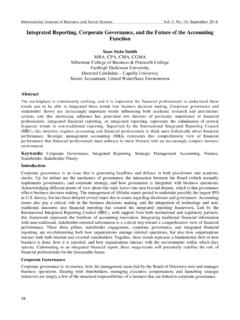Transcription of Financing in Crisis? - OECD
1 Financing in Crisis? Making humanitarian finance fit for the futureJune 2015 Rachel Scott, OECD Development Co-operation Directorate OECD DEVELOPMENT CO-OPERATION WORKING PAPER 22 Authorised for publication by Jon Lomoy, Director, Development Co-operation Directorate OECD Development Co-operation Working Papers OECD Working Papers should not be reported as representing the official views of the OECD or of its member countries. The opinions expressed and arguments employed are those of the authors. Working Papers describe preliminary results or research in progress by the author(s) and are published to stimulate discussion on a broad range of issues on which the OECD works. Comments on the present Working Paper are welcomed and may be sent to - the Development Co-operation Directorate, OECD, 2 rue Andr -Pascal, 75775 Paris Cedex 16, France. This document and any map included herein are without prejudice to the status of or sovereignty over any territory, to the delimitation of international frontiers and boundaries and to the name of any territory, city or area.
2 You can copy, download or print OECD content for your own use, and you can include excerpts from OECD publications, databases and multimedia products in your own documents, presentations, blogs, websites and teaching materials, provided that suitable acknowledgement of OECD as source and copyright owner is given. All requests for public or commercial use and translation rights should be submitted to COPYRIGHT OECD 2015 Financing in crisis ? Making humanitarian finance fit for the future Rachel Scott1 Abstract Building on the useful recommendations of the Future Humanitarian Financing initiative, this paper takes the view that ensuring enough quality money for humanitarian crises is not just about writing a bigger cheque. The money also needs to arrive in the right place, in the right way, and at the right time. The paper focuses on the following areas, learning from good practices by DAC members and attempting to find solutions to common challenges: Predictable funding for predicable costs.
3 Funding for longer-term protracted crises that helps boost the resilience of crisis -affected communities; going beyond immediate life-threatening needs and supporting self-reliance. Reworking funding tools and approaches for crises in middle income countries learning from the challenges facing the Syrian Arab Republic affected region. Thinking differently about funding disaster response and recovery, and about funding disaster affected states and local response actors. Making the money go further; reducing the cost, and increasing the cost-benefit, of humanitarian operations. 1 Rachel Scott is the Senior Policy Advisor: Humanitarian and Risk/Resilience in the Development Co-operation Directorate of the OECD. The opinions expressed and arguments employed are those of the author.
4 The author would like to thank Steve Darvill (Australia), Lydia Poole (independent consultant), the World Bank Group, Elena Bernaldo (OECD), Hugh Macleman (OECD) and Simon Scott (OECD) and for their excellent comments on an earlier draft of this paper. The author would also like to express her gratitude to Karen Jorgensen, who facilitated the research, and to Stephanie Co c who prepared the paper for publication. Key messages: making humanitarian finance fit for the future There is not enough quality money money that arrives in the right place, in the right way, and at the right time to fund humanitarian crises. The growing gap between demand and supply, failures to adapt the humanitarian system, and what has been called a dysfunctional and inefficient Financing architecture, mean that the USD 22 billion provided for humanitarian response in 2013 including USD billion from OECD Development Assistance Committee members was simply not enough (Section 1).
5 Improving the predictability of funding must be part of the solution. This will likely include more systematic multi-annual funding commitments from donors, building on the good practices we have already seen from sixteen OECD DAC members. There must also be a rethink about funding for the administration and programme support costs of operational agencies; moving away from overhead charges on programme grants in favour of grants earmarked for administration costs, or even funding with assessed (not voluntary) contributions. These options would provide greater predictability, and also more accountability, for headquarters charges. Finally, predictability will be enhanced if there is a clearer division of labour, or at least greater communication of funding intentions, among donors (Section 2). We will also need to expand the Financing pool for protracted crises.
6 The various post-2015 processes provide good opportunities for improving coherence between humanitarian and development actors working in longer-term crises. Good ideas include: shared context analysis and priorities; shifting to multi-year planning; development support to scale up social protection mechanisms; and strengthening links with multilateral banks. However, involving development actors earlier, and more intensely, in protracted crises will require changes to the humanitarian business model: the assumption that development donors will stump up funds for existing humanitarian programmes is na ve development donors no longer have the systems or incentives to provide this funding. Indeed, evidence now suggests that the humanitarian mandate has stretched beyond its core task of meeting acute needs precisely because most major development actors have chosen to abandon community-based programming in favour of state-building and national systems.
7 Instead, the pressing challenge is how to reconcile household and community focused humanitarian programming with development work focused on building the state; thereby providing a more comprehensive and coherent response in protracted crisis situations (Section 3). Donors also need to go more systematically beyond their funding role in protracted crises, and focus on other areas where they can add value: facilitating remittance flows, halting illicit financial flows, managing the impacts of small arms flows, and resolving conflict through support to political dialogue and state-building (Section 3). Crises in middle income countries (MICs) pose a special fi nancing challenge; the solution requires a paradigm shift about how to approach crises in these countries. Financing to meet crises in middle income countries is a growing problem 53% of all humanitarian funds requested in 2015 were for crises in these countries and problematical, given the limited access to anything other than pure humanitarian budgets.
8 Why can t development funds help out in MICs? Because donors, and multilateral banks, invest in middle income countries for very different reasons and using very different tools than in least developed countries. The middle income country toolbox is, not surprisingly, rather ill-suited to crisis response; therefore, most crisis funding comes from humanitarian budgets (Section 4). The solution will require a paradigm shift about how to approach crisis response in MICs: encouraging the use of development finance by focusing on building resilience in all parts of society, rather than pure crisis response; closer alignment with country priorities and using country systems, rather than assuming that the response should be conducted solely by humanitarian operational agencies; and helping development actors see crises as unique opportunities to shore up economic and social progress, allowing the full range of development instruments to come into play.
9 This type of solution might see the use of concessional loans for improving infrastructure that can deal with refugee inflows but also with future population growth; debt swaps to allow governments to reallocate planned debt repayments to social protection systems; and a focus on building the capacity and systems of local authorities that are dealing directly with the crisis (Section 4). Better finance for disasters will mean thinking differently about approaches to disaster resilience, response and recovery. Good practice examples in the Pacific might help provide a model for better quality disaster funding and response in other areas of the world. OECD DAC members in the Pacific build disaster resilience by drawing on their own domestic experience and knowledge, providing appropriate technical expertise to high disaster-risk countries.
10 Providing liquidity for disaster-affected governments is a growing trend; injecting sufficient cash flow so that partner governments can respond to the needs of their citizens when disasters strike. In addition, Pacific donors ensure that risk reduction is systematically mainstreamed into all development co-operation programming, and allow development funds to be reallocated to disaster recovery in times of need. When a disaster hits, Pacific donors favour bilateral responses government to government, building on existing relationships this response model provides useful lessons for responses to disasters in other areas of the world (Section 5). Other useful thinking about finance for disasters includes risk finance and transfer mechanisms with the proviso that these tools do not work always and everywhere. However, a note of caution, this is a very technical subject and individual donors will need to think carefully about where they can most add value.















